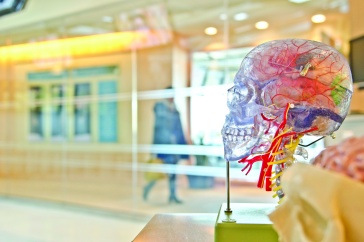
Daniel Seichepine teaches the course Drugs and Behavior at UNH Manchester.
News of the opioid crisis that has struck particularly hard in New Hampshire has included the number of deaths from overdoses (385 in 2015) and the use of the lifesaving drug Narcan and the need for treatment options. A panel of experts that visited campus discussed the complex issues of addiction and incarceration.
What hasn’t been reported is what long-term use of heroin does to the brain.
“Heroin actually causes the brain to shrink,” says Daniel Seichepine, who teaches the course Drugs and Behavior at UNH Manchester. “There is literally less brain volume. The damage is irreversible.”
When the brain shrinks, the space fills in with spinal fluid, Seichepine says. That, coupled with chemical changes that occur, impacts cognition and behavior. One study revealed the autopsied brains of heroin or methadone users to have damage similar to the early stages of Alzheimer’s.
“It seems that using heroin over time leads to brain changes that are similar to aging and Alzheimer's disease.”
“It seems that using heroin over time leads to brain changes that are similar to aging and Alzheimer's disease,” Seichepine says. He references the presence of amyloid-beta plaques and tangles (twisted strands of protein) in the brains of those with Alzheimer's. “The tangles were previously thought to be specific to Alzheimer's disease; however, nowadays we know they are found whenever there is cell death — including in heroin use.”
A clinical neuropsychologist, Seichepine introduces his students to the principles of psychopharmacology (the effects drugs can have on mood, thinking and behavior) by discussing such drugs as marijuana, opioids, LSD, mushrooms, alcohol, stimulates (cocaine, amphetamines), nicotine and over-the-counter drugs and dietary supplements. There is also discussion on brain injuries and diseases like Parkinson’s and dementia.
“The focus is on therapeutic and recreational drug use and neuropsychiatric function and dysfunction as they relate to the use or abuse of particular drugs,” Seichepine says. “We discuss addiction, including the opioid crises both locally and globally.”
To help students understand the epidemic that has gripped New Hamsphire, he has emergency responders come talk about what is happening in their communities. Hooksett Fire Department representatives told students about using Narcan to revive people who weren’t breathing, leading students to discuss their own experiences. Some students said they have family members who keep Narcan on hand.
The course also explores the social messaging related to drug use, “from Marlboro ads to Denis Leary’s ‘"No Cure for Cancer.’” There is a segment on how drugs are administered and how they work in the body and a discussion on treatment options — Alcoholics Anonymous, cognitive therapy, in-patient facilities, for example.
“I want them to understand how drugs change the brain — that they can change wiring,” Seichepine says. “And I want them to realize that those changes can’t always be undone.”
-
Written By:
Jody Record ’95 | Communications and Public Affairs | jody.record@unh.edu




















































